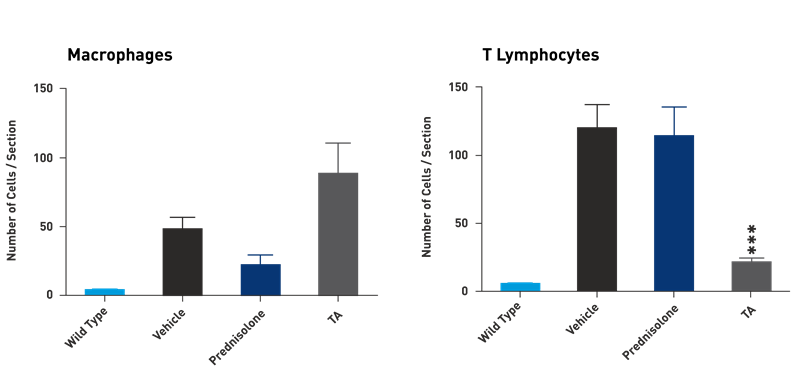B10.mdx Physiological Data
C57BL/10ScSn-Dmdmdx/J mice (001801), commonly called mdx, are the most published model of Duchenne’s muscular dystrophy. The mice carry a loss-of-function mutation in the dystrophin (Dmd) gene, and homozygotes show progressive cycles of muscle degeneration and regeneration starting at about three weeks of age.
Return to Muscular Dystrophy Efficacy Studies
Ambulation & Strength
Open Field Test
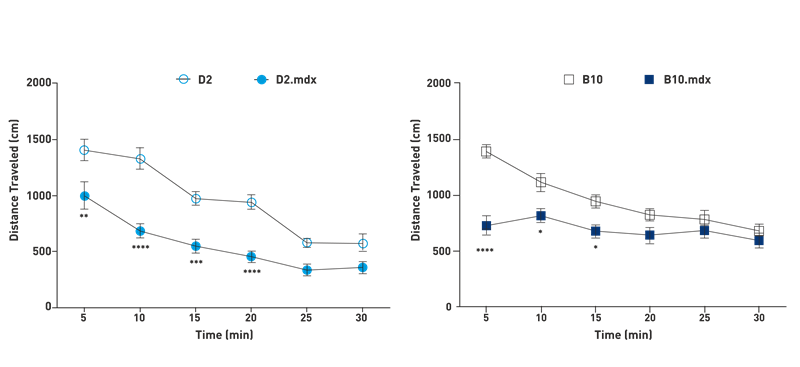
B10.mdx, D2.mdx and their wild type controls were tested in open field for 30 min. Wildtype mice initially explore their new environment, resulting in high distanced traveled. Over time they move around less. Both B10.mdx and D2.mdx move less than their wild type controls in the open field test. The D2.mdx model has a more severe ambulation deficit.
Grip Strength
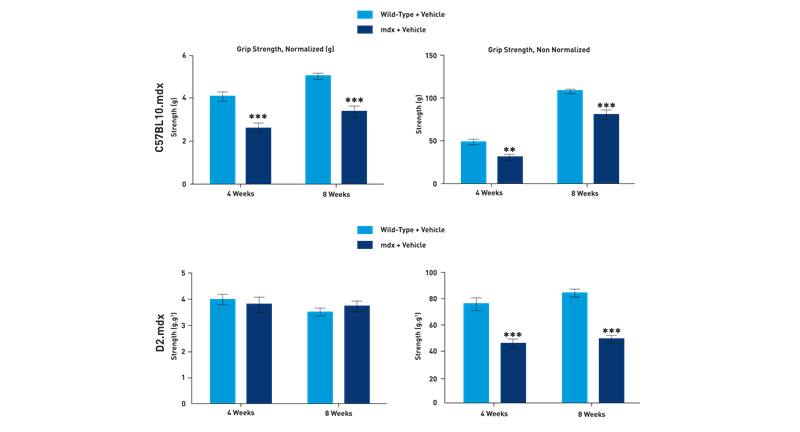
Forearms grip strength measured in an efficacy study at 4 weeks of age and after 4 weeks of treatment with the Vehicle (8 weeks of age) in wild-type and mdx mice. Grip strength can be normalized to the body weight or not. In B10.mdx, mutants have a lower strength at both ages. In D2.mdx, normalized grip strength is not significantly different between wild type and mutant mice; the difference is however strong on non-normalized values. The choice of grip strength as a read-out, and the use of normalization or not, should be discussed with your Study Director.
Force Measurement
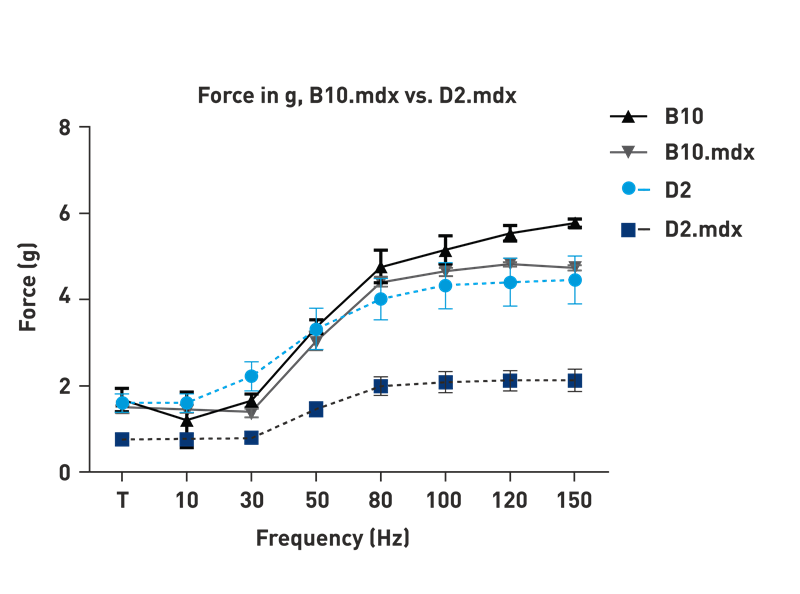
The torque of the dorsiflexion of the foot was measured in 8 week old anesthetized mice upon stimulation of the peroneal nerve. Force increases with the frequency of the stimulus. Maximum force is reached at 100-150 Hz. B10.mdx mutants have a slight decrease in force compared to wild type controls. In comparison, D2.mdx have a much greater decrease in force compared to wild type controls.
Muscle Damage
D2 vs B10.mdx Serum CK
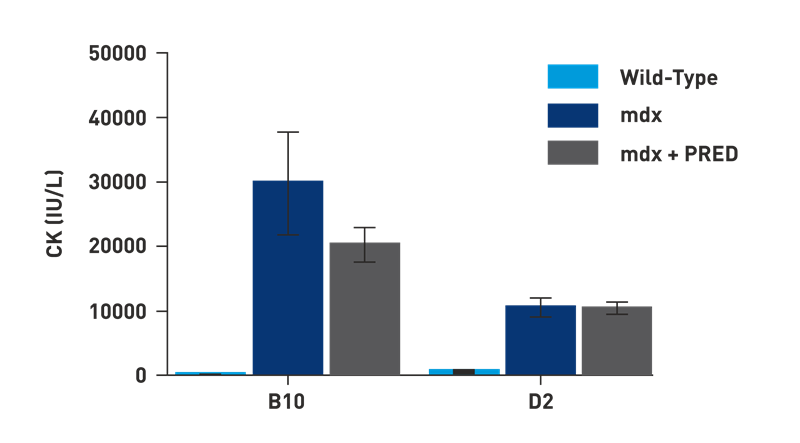
Serum creatine kinase (CK) is an indicator of muscle injury. The break down of hypertrophic, large muscle fibers in B10.mdx is associated with higher serum CK levels than in D2.mdx, characterized by atrophied muscles. Treatment of B10.mdx mice with Prednisolone(PRED) decreases the serum CK levels in B10.mdx.
Pre-/Post-Exercise Values in B10.mdx
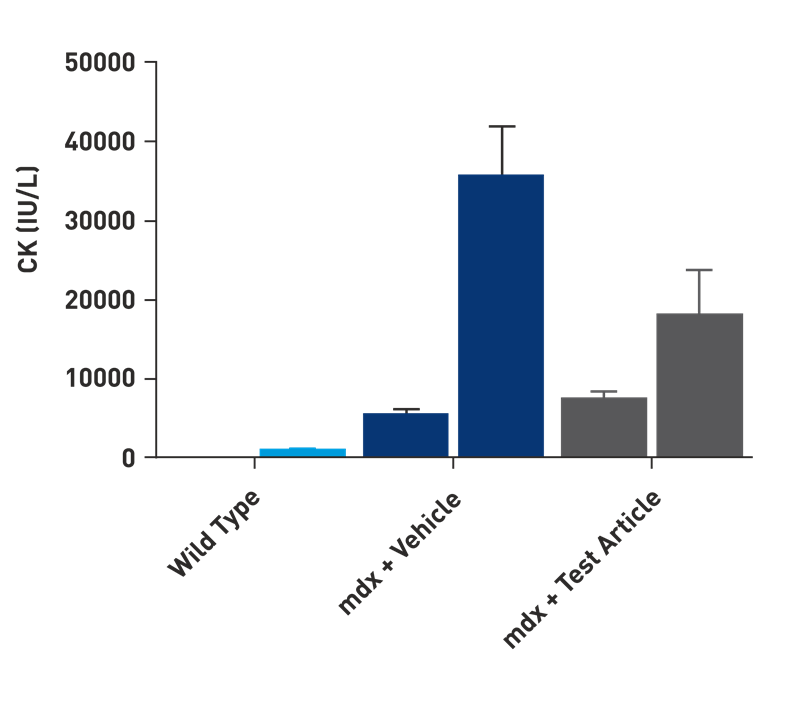
Forced exercise increases serum CK. Drugs preventing exercise-induced muscle damage can decrease post-exercise CK increase in B10.mdx mice.
Evans Blue Dye Uptake
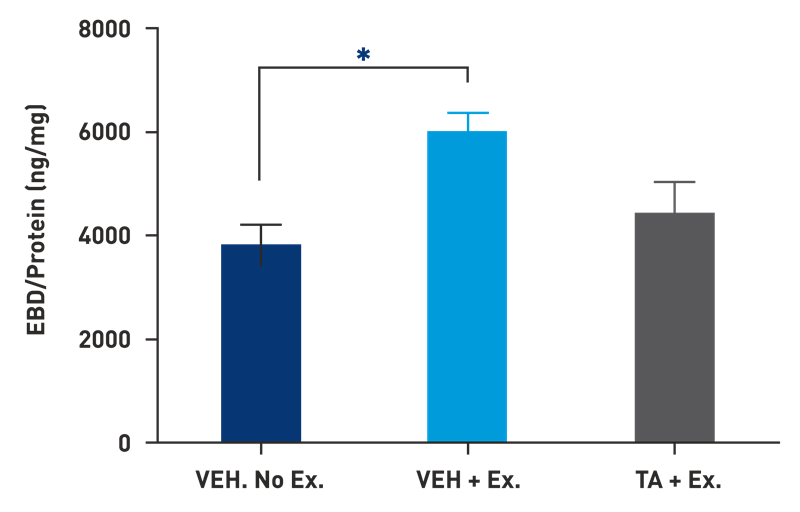
Evans Blue dye uptake is an indicator of sarcolemma damage. Exercise (Ex) causes muscle damage and thus increases Evan Blue dye uptake in the tibialis anterior muscle of vehicle (VEH) treated B10.mdx. Treatment with a test article (TA) that decreases muscle damage during exercise decreases Evans Blue dye uptake compared to the vehicle treated animal after exercise.
Fibrosis
Sirius Red staining
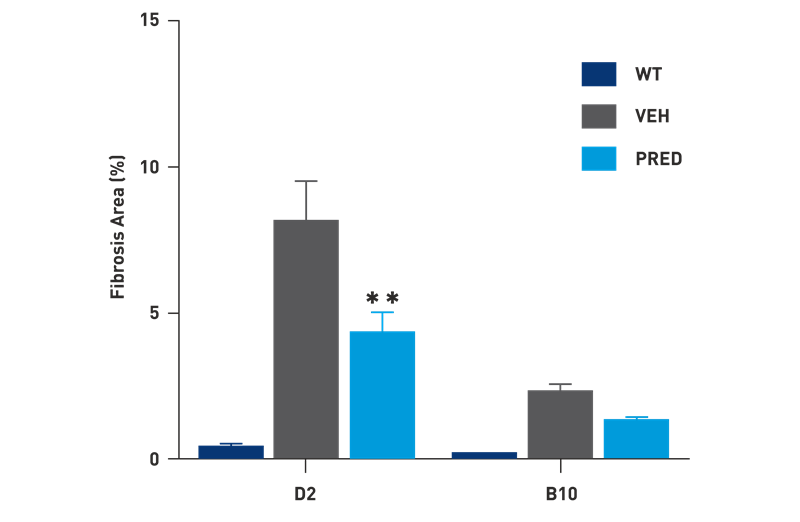
Sirius Red staining on muscle sections measures the amount of fibrosis in the skeletal muscle. D2.mdx and B10.mdx both show an increase in fibrosis over the wild type (WT) controls, but fibrosis is greater in the D2.mdx mice. Prednisolone (PRED) treated mice have a decrease in fibrosis compared to vehicle (VEH) treated mice.
Hydroxyproline
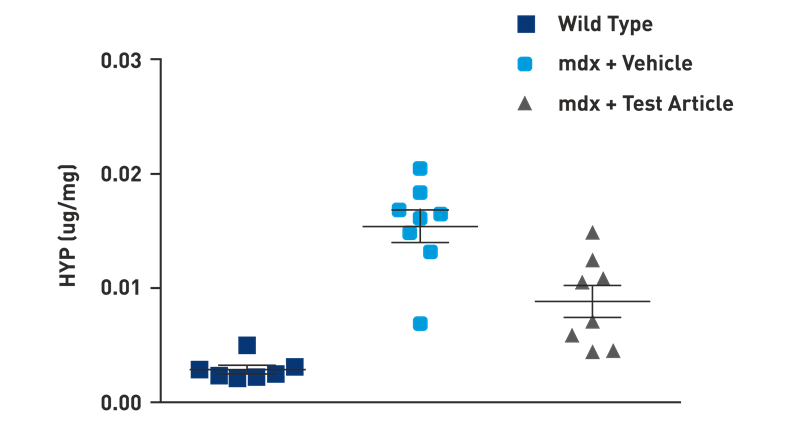
Hydroxyproline levels are a measurement of fibrosis in the skeletal muscle. The increased fibrosis in B10.mdx mice translates into an increase in hydroxyproline levels (compare mdx + Vehicle to Wild-type). A test article that decreases fibrosis decreases the hydroxyproline levels in treated B10.mdx mice (mdx + Test Article).
Inflammation
Immunohistochemistry, cell counts
Muscle inflammation is indicated by increases of F4/80-positive (macrophage) and CD3-positive (T lymphocyte) cells. Immunohistochemistry staining on muscle cross-sections for F4/80- and CD3-positive cells reveals inflammation in the diaphragm of B10.mdx mice (Vehicle) compared to the wild-type controls. Two anti-inflammatory drugs, prednisone and a test article (TA) have different effects: prednisone decreases macrophages but not T cells, while the test article has the opposite effects.
Cell Sorting
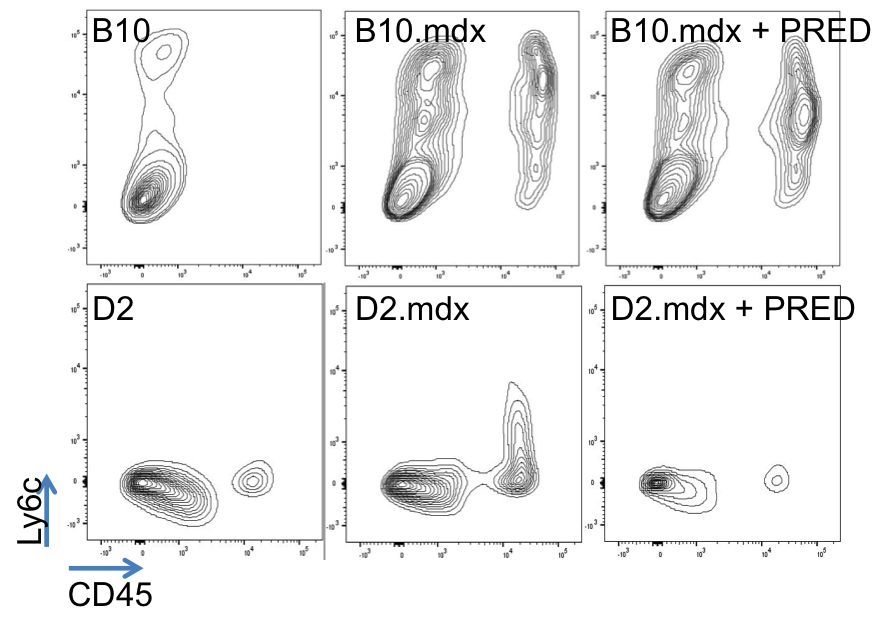
Flow Cytometry allows the enumeration of cell populations contributing to muscle inflammation and their response to anti-inflammatory test articles. Single cells isolated from the skeletal muscle are in majority CD45- in wild type mice (left); in mdx, the abundance of CD45+ (immune) cells increases. Many express Ly6c, a marker of inflammatory monocytes. The treatment of mdx with prednisone decreases the abundance of CD45+ immune cells and prevents the apparition of Ly6C+ inflammatory cells. B10.mdx muscles contain more inflammatory immune cells than D2.mdx muscles.
CD45.2+ CD11b+ cells, in number of viable cells
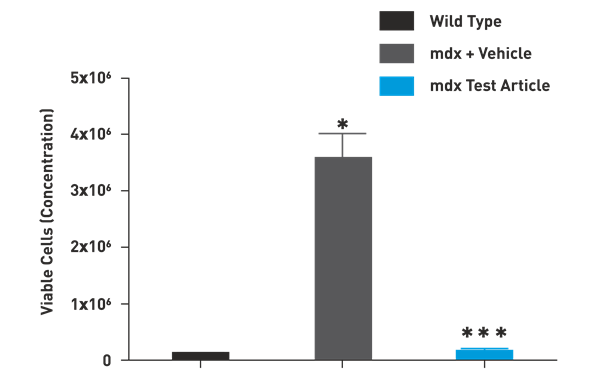
Myeloid (CD45.2+, CD11b+) cells increase during muscle inflammation. Flow Cytometry was used to enumerate these cell populations in the muscle of B10.mdx mice. B10.mdx mice have a significant increase in inflammation compared to the wild type controls. An anti-inflammatory test article reduces these cell populations close to wild type levels.
CD11c+, MHCII+ (cDC)
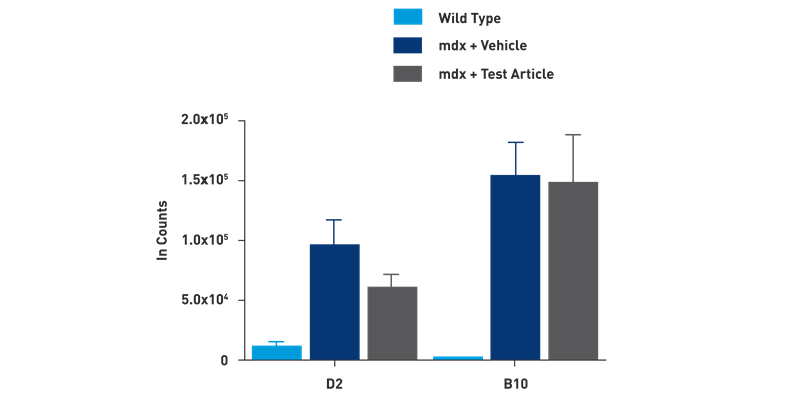
Dendritic (CD11c+, MHCII+) cells increase during muscle inflammation. B10.mdx mice have greater inflammation than D2.mdx mice by this measurement (compare mdx + Vehicle). An anti-inflammatory test article only decreased inflammation in the D2.mdx mice.
Morphometry
Histology Slides
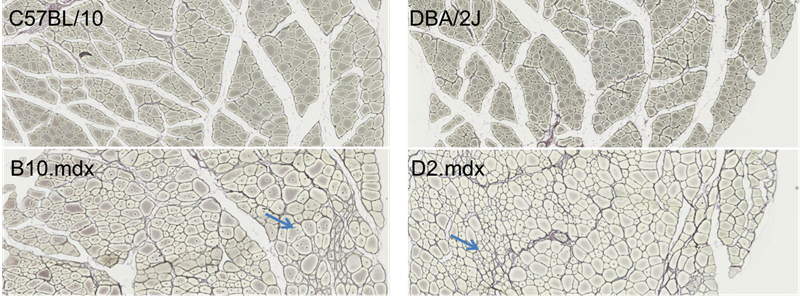
Note the abundance of large, hypertrophic fibers with central nuclei in B10.mdx compared to B10 control (left, arrow) ; D2.mdx, in contrast, presents atrophic fibers without central nuclei, indicative that a lower regenerative capacity leads to a more severe muscle wasting (right, arrow).
Automated Morphometry Measurements

Automated morphometry measurements plot the frequency distribution of muscle fibers based on their diameter and detects hypertrophy (increase in large fibers) or small, abnormal fibers. Both B10.mdx (left) and D2.mdx (right) mice have an increase in hypertrophy compared to wildtype (compare Vehicle to WT), but B10.mdx mice have greater hypertrophy than D2.mdx. In D2.mdx mice, Prednisolone (PRED) further increased the percentage of small, fibers – a side effect of long term exposure to corticoids.
